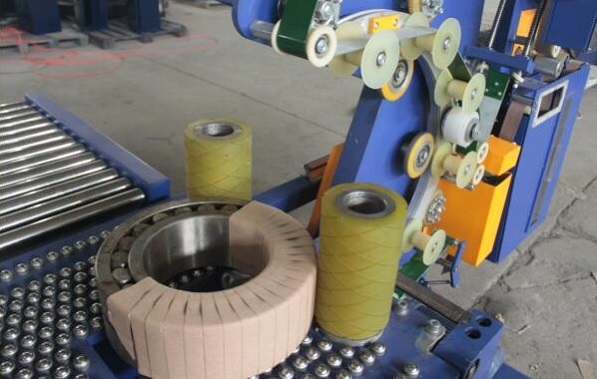Optimizing Bearing Packaging: A Guide to Wrapping Machine Selection and Operation
Proper packaging is critical for protecting precision bearings from contamination, corrosion, and physical damage during storage and transit. Automated wrapping machines offer an efficient and consistent solution for applying protective materials. Understanding the available technologies and selection criteria is key to implementing an effective bearing packaging process.
The Importance of Protective Bearing Packaging
Bearings are sensitive components. Exposure to environmental factors or improper handling can lead to:
- Corrosion: Moisture and contaminants can cause rust and etching on precision surfaces.
- Contamination: Dust, dirt, and debris can compromise bearing performance and lifespan.
- Physical Damage: Impacts or vibrations can cause brinelling (indentations) or other defects.
Effective packaging mitigates these risks, ensuring bearings reach their point of use in optimal condition, preserving shelf life, and reducing potential warranty claims or premature failures.
Types of Bearing Wrapping Machines
Several machine types cater to different bearing sizes, volumes, and protection requirements:
1. Stretch Wrapping Machines
These machines utilize linear low-density polyethylene (LLDPE) stretch film to tightly wrap bearings or bearing stacks. Key features include:
- Process: Film is stretched and applied under tension around the bearing.
- Benefits: Good load containment, dust and moisture protection, relatively low material cost. Pre-stretch capabilities optimize film usage.
- Applications: Suitable for various sizes, often used for unitizing multiple items or as an outer protective layer.
2. Shrink Wrapping Machines
Shrink wrappers enclose bearings in a polyolefin or PVC film, which is then heated (typically in a heat tunnel) to shrink tightly around the product.
- Process: Bearing is loosely enveloped in film, then heat is applied to shrink the film.
- Benefits: Creates a conforming, tamper-evident package; excellent protection against environmental factors.
- Applications: Ideal for irregularly shaped bearings or when a very snug fit is required.
3. Paper Wrapping Machines (Including VCI)
These machines apply paper-based materials, often crucial for long-term corrosion protection.
- Kraft Paper: Provides basic physical protection against scratches and minor impacts.
- VCI Paper (Vapor Corrosion Inhibitor): This is a critical material for ferrous and non-ferrous metal bearings. The paper is impregnated with VCI chemicals that vaporize and form a protective molecular layer on the metal surfaces, inhibiting corrosion even without direct contact.
- Process: Machine wraps the paper around the bearing, often with options for folding or sealing.
- Applications: Essential for bearings requiring extended storage or shipping in potentially corrosive environments.
Key Considerations for Selecting a Bearing Wrapping Machine
Choosing the right equipment involves evaluating several factors:
- Bearing Characteristics: Consider the size range (diameter, width), weight, geometry, and material sensitivity of the bearings being packaged.
- Protection Requirements: Determine the necessary level of protection against moisture, corrosion (consider VCI), dust, and impact.
- Packaging Material: Ensure compatibility between the machine and the desired wrapping materials (specific film types, VCI paper grades).
- Level of Automation: Options range from manual loading/operation to semi-automatic and fully automated systems integrated with conveyors and robotic handling. Assess needs based on volume and labor availability.
- Throughput: Define the required packaging speed (bearings per minute/hour) to meet production demands.
- Footprint and Integration: Consider available floor space and how the machine will fit into the existing production workflow.
- Budget and ROI: Evaluate the initial investment against potential savings in labor, material waste reduction, and improved product protection.
For further details on specific machine capabilities and configurations, you can explore bearing packing machine specifications.

Essential Maintenance for Wrapping Machines
Consistent performance and longevity depend on proper maintenance. Adhere to the manufacturer's recommendations, which typically include:
- Regular Cleaning: Keep the machine free of dust, debris, and residue from packaging materials. Pay attention to sensors, rollers, and sealing/cutting mechanisms.
- Lubrication: Apply appropriate lubricants to moving parts (chains, bearings, guides) according to the recommended schedule.
- Inspection: Regularly inspect wear parts such as belts, rollers, heaters (for shrink systems), cutters, and safety guards. Check for proper alignment and tension of film/paper feeds.
- Operator Training: Ensure operators are properly trained on machine operation, safety procedures, material loading, and basic troubleshooting.
- Preventive Maintenance: Follow a scheduled preventive maintenance program as outlined by the manufacturer to address potential issues before they cause downtime.
Investing time in selection and maintenance ensures your bearing wrapping machine operates efficiently, providing consistent and reliable protection for critical components throughout the supply chain.